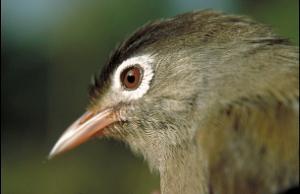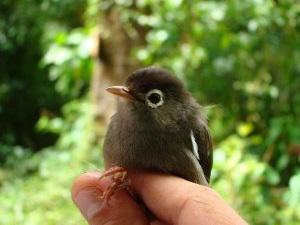Andrea Baquero
This project aims to understand the effects of anthropogenic habitat changes in the divergence of mate recognition systems in an endemic oceanic island passerine (the São Tomé Speirops).

Head of Speirops lugubris. © M.Melo.
Recent studies have shown that ecological factors can promote population divergence even in the face of gene flow, when the diverging populations are subjected to different selective pressures. Natural selection may also impact directly on traits that are usually considered to be under sexual selection, such as mate recognition traits. Although not much is known about the evolutionary responses of populations to the widespread impact of anthropogenic activities, it is expected that these will create new selective regimes.

Speirops lugubris. © A.Baquero.
The island of São Tomé offers an excellent opportunity to investigate the ability of species to adapt to anthropogenic environmental change because it has been uninhabited and covered by undisturbed rainforest until the last 500 years, with shade-forest cocoa and coffee plantations being a new habitat only for about the last 150-200 years.
The São Tomé Speirops Speirops lugubris, a passerine endemic to the island of São Tomé, is a very common species presenting a wide distribution throughout the island. The genus Speirops is endemic to the Gulf of Guinea; it comprises the four species of phenotypically ‘aberrant’ white-eyes (Zosteropidae), each co-occurring with a ‘typical’ white-eye from the genus Zosterops. On São Tomé and Principe, these atypical species represent very recent speciation events, characterized by a very fast rate of phenotypic evolution (Melo, 2007). In particular, I have previously shown that Speirops lugubris individuals are significantly smaller on plantations than on the original forest (unpublished data).
The objective of this study is to analyse song structure and composition variation of Speirops lugubris between two habitat types in São Tomé, forest and shade forest plantations, in order to determine if micro-evolution can take place in such a small spatial and temporal scale in the face of gene flow. Results of this study will be of direct relevance for understanding the evolutionary response of small island populations to human-altered environments.
For song analysis, I intend to record various individuals at different forest and plantation sites on the island over a period of one month starting January 2008. There are clear theoretical predictions on the direction of change in these traits in relation to the sound transmission properties of different habitats. Therefore, I also aim to collect descriptive data for both habitat types that will help determining the ecological correlates of song variation. Habitat data will also be very useful to interpret the morphological differences that have been found in this system.